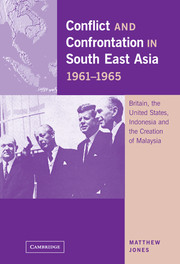 Conflict and Confrontation in South East Asia, 1961–1965
Conflict and Confrontation in South East Asia, 1961–1965 Book contents
- Frontmatter
- Contents
- List of maps
- Preface and acknowledgements
- List of abbreviations
- South East Asia
- Indonesia and Malaysia
- Introduction: Britain, the United States and the South East Asian setting
- Part I Build-up
- Part II Outbreak
- Part III Denouement
- Conclusion: The Western presence in South East Asia by the 1960s
- Bibliography
- Index
Conclusion: The Western presence in South East Asia by the 1960s
Published online by Cambridge University Press: 25 July 2009
- Frontmatter
- Contents
- List of maps
- Preface and acknowledgements
- List of abbreviations
- South East Asia
- Indonesia and Malaysia
- Introduction: Britain, the United States and the South East Asian setting
- Part I Build-up
- Part II Outbreak
- Part III Denouement
- Conclusion: The Western presence in South East Asia by the 1960s
- Bibliography
- Index
Summary
In 1945, the Western powers had secured an overwhelming but in many ways ambiguous victory over Japan, and it remained to be seen how long they could preserve their formal presence in South East Asia faced with the assertive forces of nationalism that had been unleashed by that conflict. Among the Europeans, the Dutch retreated from their East Indies Empire in 1949, and had their assets seized and remaining citizens driven out of Indonesia in December 1957, while the French had the even more painful experience of defeat on the battlefield and eviction from Indochina in 1954. The British, by contrast, felt they had achieved the right balance through progressive colonial policies and the prudent exercise of force, with a benevolent United States to support them. The Malayan settlement of 1957 was the model to be emulated; a conviction existed that new Asian states could be directed towards stable Western-derived models of economic development and a foreign policy that was alert to the dangers of Communist domination. ‘South East Asia is … politically adolescent with teenage weaknesses of exuberance, xenophobia, inexperience and irresponsibility’, Sir Robert Scott condescendingly remarked to Macmillan in May 1959, ‘Guiding the strong new forces of nationalism into constructive channels and coping with the hydra of communist penetration in all its forms demand patience and perseverance.’
- Type
- Chapter
- Information
- Conflict and Confrontation in South East Asia, 1961–1965Britain, the United States, Indonesia and the Creation of Malaysia, pp. 295 - 304Publisher: Cambridge University PressPrint publication year: 2001


